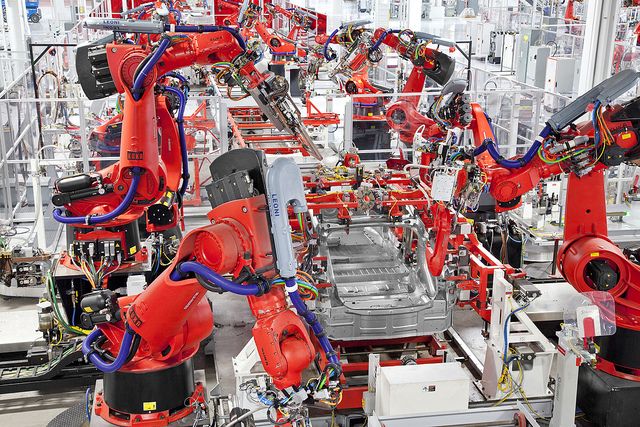When NASA’s space shuttle program retired in 2011, American astronauts were left with no way of transport to and from the International Space Station, except by Russian spacecraft. Considering tensions are now high between the two countries, thanks to Russia’s takeover of the Crimea region of Ukraine, NASA is looking for new options.
Page 11870

It’s impossible to overstate how much the Internet matters. It has forever altered how we share information and store it for safekeeping, how we communicate with political leaders, how we document atrocities and hold wrongdoers accountable, how we consume entertainment and create it, even how we meet others and maintain relationships. Our society is strengthened and made more democratic by the open access the Internet enables. But the Internet as we know it is at risk from a variety of threats ranging from cybercrime to its very infrastructure, which wasn’t built to withstand the complications our dependence upon it causes.
We asked some of the Net’s biggest stakeholders and thought leaders to lay out ways we can maintain the Internet as a home for innovation, community, and freely exchanged information. We are excited to present you with these six takes on what could go wrong—and how to bring us back from the brink.
Sep 5, 2014
What Boeing’s space taxi could mean for the future of commercial space travel
Posted by Seb in category: space travel
By Robin Burks — TechTimes

Sep 4, 2014
Navy’s Next Fighter Likely to Feature Artificial Intelligence
Posted by Seb in categories: defense, robotics/AI
By: Dave Majumdar — USNI News

Artificial intelligence will likely feature prominently onboard the Pentagon’s next-generation successors to the Boeing F/A-18E/F Super Hornet and the Lockheed Martin F-22 Raptor.
“AI is going to be huge,” said one U.S. Navy official familiar with the service’s F/A-XX effort to replace the Super Hornet starting around 2030.
Further, while there are significant differences between the U.S. Air Force’s vision for its F-X air superiority fighter and the Navy’s F/A-XX, the two services agree on some fundamental aspects about what characteristics the jet will need to share.
Sep 3, 2014
Five Myths and Facts About Robotics Technology Today
Posted by Seb in category: robotics/AI

Ever faster processors, cheaper sensors, abundant open-source code, ubiquitous connectivity, and the advent of 3D printing are some of the forces behind the recent proliferation of robots. As I see things, these forces will only get stronger, and as more robots become part of our lives—in homes, offices, factories, hospitals, and many other places—we’ll inevitably face challenges involving our adoption and use of robots.
Some observers are voicing their fears about a decline in human-human interaction, while others warn of an irreversible and senseless loss of jobs, with robots taking over tasks that, they argue, should not be performed by machines (such as caring for the elderly). Trade-offs will certainly be part of our growing reliance on robotics and automation. And it will be up to us to manage these trade-offs, just as we have with other technologies such as electricity, the automobile, aviation, nuclear power, computers, and the Internet.
TJ McCue — Forbes

Depending on where you get your statistics, there are between 10 and 15 million amputees in the world. People who lose a limb go through a lot of pain obviously and the challenge to get a prosthetic limb that allows them to fully function again often doesn’t lessen the emotional pain aspect. It is a difficult process. Plus, it is not inexpensive. In this week’s news, there is a post about a young man in Ottawa who needs help to purchase a new prosthetic leg and he’s taken his need to crowdfunding on YouCaring.com.
Selvan Mohan is a PhD candidate at Carleton University. The university will help cover $10,000 of the $22,000 needed. His campaign is almost 50 percent funded. A group of people, friends included, got together to help him create the video which you can watch here. I found Mr. Mohan’s story compelling and worthy (check out the video), but what do you do if you cannot take your case to the powerful crowd-funding platforms?
Sep 2, 2014
Virtually Human, by Martine Rothblatt, Ph.D.
Posted by Karlyn Hixson in categories: life extension, transhumanism
In Virtually Human, you’ll have the privilege of meeting Bina48, the world’s most sentient robot, commissioned by Martine Rothblatt and created by Hanson Robotics. Bina48 is a nascent Mindclone of Martine’s wife that can engage in conversation, answer questions, and even have spontaneous thoughts that are derived from multimedia data in a Mindfile created by the real Bina (be sure to check her out on Twitter too – @iBina48!).
If you’re personally active on Twitter or Facebook, share photos through Instagram, or blog regularly, you’re also already on your way to creating a Mindfile – a digital database of your thoughts, memories, feelings, and opinions. And soon, this Mindfile can be made conscious with special software—Mindware—that mimics the way human brains organize information, create emotions and achieve self-awareness. Virtually Human is the only book to examine the ethical issues relating to cyberconsciousness and Rothblatt, with a Ph.D. in medical ethics, is uniquely qualified to lead the dialogue. On sale Sept 9th, I wanted to be sure everyone at Lifeboat knew about it, and you can pre-order your copy today: http://smarturl.it/vhaz and http://smarturl.it/bnVh.
Sep 1, 2014
Two numerical Sinai-type Theorems
Posted by Otto E. Rössler in category: particle physics
T1: A numerical instability applies to time-inverted trajectories in deterministic statistical thermodynamics.
T2: A numerical instability applies to non-time inverted trajectories in deterministic statistical cryodynamics.
Cryodynamics in contrast to thermodynamics is based on inter-particle attraction rather than inter-particle repulsion. T2 implies that in numerical simulations of attraction-based gases, markedly deviating trajectories are necessarily generated. Since this fact went unrecognized, a whole new time’s arrow got overlooked numerically.
Sep 1, 2014
5 US States Poised to Promote Bitcoin-Friendly Regulation
Posted by Seb in category: bitcoin
Daniel Cawrey (@danielcawrey) — Wired
Given the recent critiques of New York and its proposed framework for bitcoin businesses, many of the law’s opponents are no doubt hoping the state and its regulators will alter the bill during its now extended comment period.
After all, New York’s BitLicense proposal, once approved, could prove influential at shaping wider US bitcoin regulation, a fact recently underscored by New York Department of Financial Services (NYDFS) superintendent Ben Lawsky in an interview with CoinDesk.
Aug 31, 2014
What Sci-Fi Movies Get Right and Wrong About Time Travel
Posted by Seb in category: time travel
By Roxanne Palmer and Julie Rossman — Slate

One trope in time travel science fiction is slightly plausible, if physically impossible—traveling faster than the speed of light. The crew of the U.S.S. Enterprise did this in Star Trek IV: The Voyage Home, by using the sun’s gravitational pull to accelerate their spaceship to super-light speed. If it were possible to travel faster than light (Einstein calculated it would take an infinite amount of power), it is theoretically possible for signals to be sent back in time; it’s questionable if the same method could work with people.










